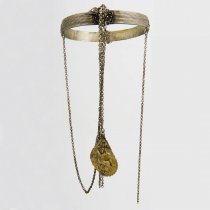A Cretan icon from Eastern Thrace
Icon with the allegorical representation “Christ the Vine”.
16th century.
BXM 2031
The representation “Christ the Vine” illustrates in an allegorical manner the passage 15:1–2 from the Gospel according to John: “Ἐγώ εἰμι ἡ ἄμπελος ἡ ἀληθινή, καὶ ὁ πατήρ μου ὁ γεωργός ἐστί. Πᾶν κλῆμα ἐν ἐμοὶ μὴ φέρον καρπὸν, αἴρει αὐτό, καὶ πᾶν τὸ καρπὸν φέρον, καθαίρει αὐτό, ἵνα πλείονα καρπὸν φέρῃ” (“I am the true vine, and my Father is the gardener. He cuts off every branch in me that bears no fruit, while every branch that does bear fruit, he prunes so that it will be even more fruitful”).*The open book on the lap of the blessing Christ paraphrases the Gospel’s passage as follows: “Ἐγώ εἰμι ἡ ἄμπελος, ὑμεῖς τὰ κλήματα, καὶ ὁ Πατήρ μου ὁ γεωργός ἐστιν. Πᾶν κλῆμα ἐν ἐμοὶ μὴ …” (“I am the vine, you are the branches and my Father is the gardener. He cuts off every branch in me …”. The branches referred to by Christ in this phrase are primarily the twelve Apostles depicted sitting on the vine branches around Christ. However, they are also identified as the faithful who behold the icon that is inscribed on the top part with the phrase “ΕΓΩ ΜΕΝ ΕΣΤΙΝ ΑΜΠΕΛΟΣ ΣΩΤΗΡ, ΒΟΤΡΥΑΣ Δ’ ΕΦΥΝ ΒΛΥΖΟΝΤΑ(Σ) ΚΟΙΝῼ” (I am the vine that salvages, the grapes that grow from me yield (their juice) for all”.
The reference to the juice of grapes, namely wine, alludes to the central act of worship, the Eucharist. On the other hand, the allegory of Christ as vine derives mainly from the Christian interpretation of the passage 15–16 of Psalm 79 (80), in which the psalmist requests God to watch over this vine, the root His right hand has planted, and the “Son of Man” He has raised up for Himself.**
The refugee heirloom displayed here was painted in a Cretan workshop, but comes from Rhaedestos on the south coast of Eastern Thrace. We do not know when and how the icon reached Rhaedestos; however, it is well established that 16th-century Cretan icons were particularly popular and were spread across the entire Orthodox world during the time of their creation, but also in the 17th–18th century.
Georgios Soteriou received the icon with proof of receipt by the Asia Minor Refugee Heirlooms Committee on March 30 1927. He displayed it in 1930 on the upper floor of “Villa Ilissia”, hung on the north wall of Room II, where icons dating between the 16th and the 18th century were exhibited. It remained there at least until the 1960s. In 2010 it was moved to the new permanent exhibition. Of the refugee heirlooms kept at the Byzantine and Christian Museum, it is the sole work that can be unreservedly ascribed to a Cretan workshop.
* John 15:1–2 (New International Version – UK), www.biblegateway.com
** Paraphrase from: Psalm 80:15 (New International Version – UK), www.biblegateway.com



.jpg)
.jpg)
.jpg)
.jpg)
 Purple Gospel
Purple Gospel .jpg) The double-sided icon from Tuzla
The double-sided icon from Tuzla .jpg) An emblematic refugee “relic”
An emblematic refugee “relic”  A byzantine Hodegetria
A byzantine Hodegetria  An Evangelistary from Trebizond
An Evangelistary from Trebizond .jpg) A significant Palaeologan work
A significant Palaeologan work  Tetraevangelion from Adrianople
Tetraevangelion from Adrianople .jpg) A Cretan icon from Eastern Thrace
A Cretan icon from Eastern Thrace .jpg) “Joined in matrimony”
“Joined in matrimony”  A peculiar neckband
A peculiar neckband  Fragmented memory
Fragmented memory .jpg) Zumzud, the pilgrim
Zumzud, the pilgrim .jpg) A refugee heirloom in “Russian style”
A refugee heirloom in “Russian style” .jpg) An unusual “icon” from Cappadocia
An unusual “icon” from Cappadocia .jpg) "He (the Lord) keeps all their bones …" (Psalm 33: 21)
"He (the Lord) keeps all their bones …" (Psalm 33: 21) .jpg) A Karamanli icon
A Karamanli icon 



